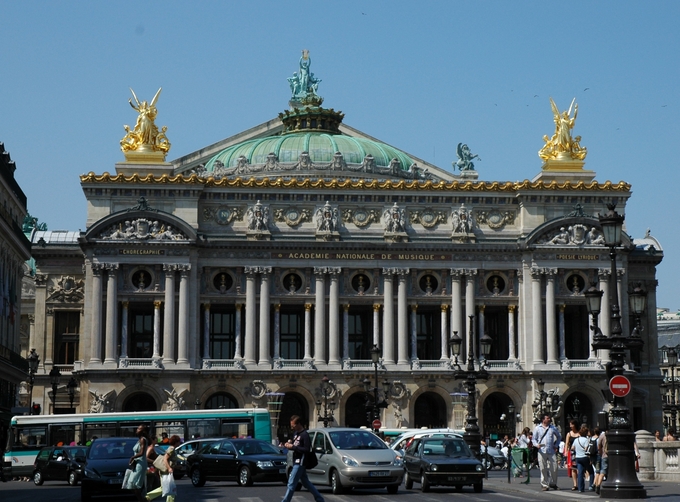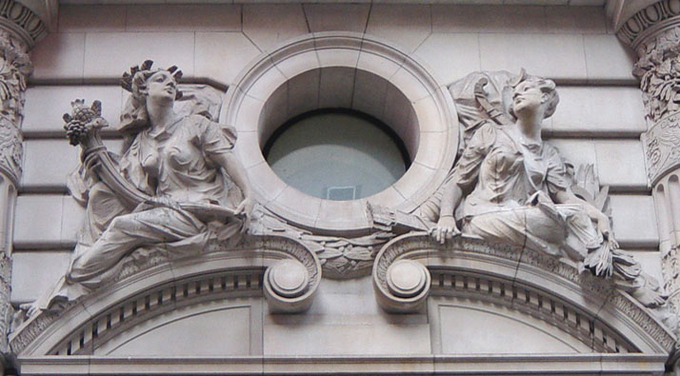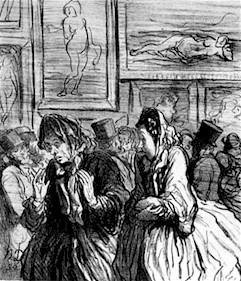28.7: Academic Art
- Page ID
- 53124
Academic Architecture
Beaux-Arts architecture expressed the academic neoclassical architectural style that was taught at the École des Beaux-Arts in Paris.
Learning Objectives
Define the characteristics of “Beaux Arts” in France
Key Takeaways
Key Points
- “Beaux Arts” describes the architectural style of over two centuries of instruction under academic authority: first, of the Académie royale d’architecture (1671–1793), then, following the French Revolution, the Architecture section of the Académie des Beaux-Arts.
- Beaux-Arts academic training emphasized the mainstream examples of Imperial Roman architecture, Italian Renaissance, and French and Italian Baroque models.
- Beaux-Arts architecture depended on sculptural decoration along conservative modern lines, combined with an impressionistic finish. Slightly overscaled details, bold sculptural supporting consoles, rich deep cornices, swags, and lavish sculptural enrichments, all flourished in the Beaux-Arts style.
Key Terms
- Beaux-Arts Architecture: Beaux-Arts architecture expresses the academic neoclassical architectural style taught at the cole des Beaux-Arts inParis.
Beaux-Arts architecture expresses the academic neoclassical architectural style taught at the École des Beaux-Arts in Paris. “Beaux Arts” describes the architectural style of over two centuries of instruction under academic authority: first, of the Académie royale d’architecture (1671–1793), then, following the French Revolution, the Architecture section of the Académie des Beaux-Arts. The style of instruction that produced Beaux-Arts architecture continued without major interruption until 1968. The Beaux-Arts style had widespread influence outside of France, including on the architecture of the United States in the period from 1880–1920.
Beaux-Arts academic training emphasized the mainstream examples of Imperial Roman architecture, Italian Renaissance, and French and Italian Baroque models. Beaux-Arts training made great use of agrafes (clasps that link one architectural detail to another), interpenetration of forms, and “speaking architecture” (architecture parlante) in which supposed appropriateness of symbolism could be taken to literal-minded extremes. Beaux-Arts training also emphasized the production of quick conceptual sketches, highly-finished perspective presentation drawings, close attention to the program, and knowledgeable detailing. Site considerations tended toward social and urbane contexts. All architects-in-training passed through the obligatory stages—studying antique models, constructing analos, analyses reproducing Greek or Roman models, “pocket” studies and other conventional steps—in the long competition for the few desirable places at the Académie de France à Rome.
Beaux-Arts architecture depended on sculptural decoration along conservative modern lines, employing French and Italian Baroque and Rococo formulas, combined with an impressionistic finish and realism. Slightly overscaled details, bold sculptural supporting consoles, rich deep cornices, swags, and lavish sculptural enrichments, all flourished in the Beaux-Arts style, as demonstrated in the Opera Garnier in Paris.

Opera Garnier: The Palais Garnier (1861-75) is an exemplar of the Beaux Arts style.
Though the Beaux-Arts style embodies an approach to a regenerated spirit within the grand traditions rather than a set of motifs, principal characteristics of Beaux-Arts architecture included: rusticated and raised first stories, a hierarchy of spaces (from “noble spaces”—grand entrances and staircases— to utilitarian ones) arched windows, arched and pedimented doors, classical details, references to a synthesis of historicist styles, and tendency to eclecticism. Statuary, sculpture (including bas-relief panels, figural sculptures, sculptural groups), murals, mosaics, and other artwork, all coordinated in theme to assert the identity of the building in Beaux-Arts architecture. After centuries of dominating architectural schools and training processes, the Beaux-Arts style began fade in favor of Modernist architecture and the International Style on the eve of World War I.

Diana and Pomona: Images of the Goddesses Pomona (left) and Diana (right) together decorate the entrance to The Peninsula Hotel, occupying a Beaux-Arts building at Fifth Ave. and 55th St., New York City. Here, Pomona (Goddess of Orchards) carries a cornucopia; in other images she is represented carrying a platter of fruit. Diana, as Goddess of the Hunt, carries her usual bow and arrows. Note the naturalism of the postures and the channeled rustication of the stonework.
Academic Painting and Sculpture
Academic art is a style of painting and sculpture produced under the influence of European academies of art.
Learning Objectives
Relate the painting and sculpture of Academia to the Neoclassicist and Romantic movements of the era
Key Takeaways
Key Points
- The Académie Royale de Peinture et de Sculpture had a considerable impact on the subjects and styles of academic art for several centuries.
- The trend in academic art was towards greater idealism, contrary to realism, so that figures could represent the ideals they stood for.
- Academic Art exhibitions were held often, and the most popular exhibition was the Paris Salon and beginning in 1903, the Salon d’Automne.
Key Terms
- Neoclassicism: Neoclassicism is the name given to Western movements in the decorative and visual arts, literature, theater, music, and architecture that draw inspiration from the “classical” art and culture of Ancient Greece or Ancient Rome.
- Rococo: Rococo, also referred to as Late Baroque, is an 18th century artistic movement and style that affected several aspects of the arts, including painting, sculpture, architecture, interior design, decoration, literature, music, and theater.
- Romanticism: 18th century artistic and intellectual movement that stressed emotion, freedom and individual imagination
Academic art is a style of painting and sculpture produced under the influence of European academies of art; more specifically, it is the art and artists influenced by the standards of the French Académie des Beaux-Arts, which practiced under the movements of Neoclassicism and Romanticism. In this context it is often called academism, academicism, L’art pompier, and eclecticism, and sometimes linked with historicism and syncretism.
Background
The Académie Royale de Peinture et de Sculpture was founded in France in 1648, and later became the Académie des Beaux-Arts. After the Académie Royale de Peinture et de Sculpture was reorganized in 1661 by Louis XIV, a controversy occurred among the members that dominated artistic attitudes for the rest of the century. This “battle of styles” was a conflict over who was a suitable model to follow—Peter Paul Rubens or Nicolas Poussin. Followers of Poussin, called “poussinistes,” argued that line (disegno) should dominate art because of its appeal to the intellect, while followers of Rubens, called “rubenistes,” argued that color (colore) should dominate art because of its appeal to emotion. The debate was revived in the early 19th century, under the movements of neoclassicism typified by the artwork of Jean Auguste Dominique Ingres, and romanticism typified by the artwork of Eugène Delacroix. Debates also occurred over whether it was better to study art by looking at nature, or to learn by looking at the artistic masters of the past. Academies using the French model formed throughout Europe, and imitated the teachings and styles of the French.
Subject Matter
The trend in academic art was towards greater idealism: contrary to realism, figures were made simpler and more abstract—idealized—in order to represent the ideals they stood in for. Hence, many paintings by academic artists are simple nature allegories with titles like Dawn, Dusk, Seeing, and Tasting, where these ideas are personified by a single nude figure, composed in such a way as to bring out the essence of the idea. This would involve both generalizing forms seen in nature, and subordinating them to the unity and theme of the artwork.
Because history and mythology were considered fertile ground for important allegory, using themes from these subjects was considered the most serious form of painting. A hierarchy of genres, originally created in the 17th century, was valued, where history painting —classical, religious, mythological, literary, and allegorical subjects—was placed at the top. Next came genre painting, then portraiture, still-life, and finally landscape. History painting was also known as the “grande genre.” During the reign of academic art, the paintings of the Rococo era that had previously been held in low favor were revived to popularity, and themes often used in Rococo art such as Eros and Psyche were popular again. The academic art world also idolized Raphael for the ideality of his work.

Birth of Venus by Alexandre Cabanel, 1863: Academic Art, especially in the Neoclassical period, typically used Roman and Greek allegories and simple nudes to depict idealized forms.
Salons
Academic Art exhibitions were held often. The most popular exhibition was the Paris Salon, and beginning in 1903, the Salon d’Automne. These salons were sensational events that attracted crowds of visitors, both native and foreign. As much a social affair as an artistic one, 50,000 people might visit on a single Sunday, and as many as 500,000 could see the exhibition during its two-month run. Thousands of pictures were displayed, hung from just below eye level all the way up to the ceiling in a manner now known as “Salon style.” A successful showing at the salon was a seal of approval for an artist, making his work saleable to the growing ranks of private collectors.
Criticisms
Academic art was first criticized by realist artists for its use of idealism: based on idealistic clichés and representing mythical and legendary motives while contemporary social concerns were being ignored. Another criticism by realists was the “false surface” of paintings: the objects depicted looked smooth, slick, and idealized, showing no real texture. Similarly, perspective was constructed geometrically on a flat surface and was not really the product of sight.

- Curation and Revision. Provided by: Boundless.com. License: CC BY-SA: Attribution-ShareAlike
- Beaux-Arts architecture. Provided by: Wikipedia. Located at: en.Wikipedia.org/wiki/Beaux-Arts_architecture. License: CC BY-SA: Attribution-ShareAlike
- Beaux-Arts Architecture. Provided by: Wikipedia. Located at: en.Wikipedia.org/wiki/Beaux-Arts%20Architecture. License: CC BY-SA: Attribution-ShareAlike
- DianaAndPomona. Provided by: Wikimedia Commons. Located at: commons.wikimedia.org/wiki/File:DianaAndPomona.jpg. License: CC BY-SA: Attribution-ShareAlike
- Facade opera Garnier. Provided by: Wikimedia Commons. Located at: commons.wikimedia.org/wiki/File:Facade_opera_Garnier.jpg. License: Public Domain: No Known Copyright
- Academic art. Provided by: Wikipedia. Located at: en.Wikipedia.org/wiki/Academic_art. License: CC BY-SA: Attribution-ShareAlike
- Neoclassicism. Provided by: Wikipedia. Located at: en.Wikipedia.org/wiki/Neoclassicism. License: CC BY-SA: Attribution-ShareAlike
- Romanticism. Provided by: Wiktionary. Located at: en.wiktionary.org/wiki/Romanticism. License: CC BY-SA: Attribution-ShareAlike
- Rococo. Provided by: Wikipedia. Located at: en.Wikipedia.org/wiki/Rococo. License: CC BY-SA: Attribution-ShareAlike
- DianaAndPomona. Provided by: Wikimedia Commons. Located at: commons.wikimedia.org/wiki/File:DianaAndPomona.jpg. License: CC BY-SA: Attribution-ShareAlike
- Facade opera Garnier. Provided by: Wikimedia Commons. Located at: commons.wikimedia.org/wiki/File:Facade_opera_Garnier.jpg. License: Public Domain: No Known Copyright
- This Year Venuses Again (Daumier). Provided by: Wikipedia. Located at: en.Wikipedia.org/wiki/File:This_Year_Venuses_Again_(Daumier).jpg. License: Public Domain: No Known Copyright
- Cabanel - El Nacimiento de Venus (Museo de Orsay, Paru00eds, 1863.nu00d3leo sobre lienzo, 130 x 225 cm). Provided by: Wikipedia. Located at: en.Wikipedia.org/wiki/File:Cabanel_-_El_Nacimiento_de_Venus_(Museo_de_Orsay,_Par%C3%ADs,_1863._%C3%93leo_sobre_lienzo,_130_x_225_cm).jpg. License: Public Domain: No Known Copyright

